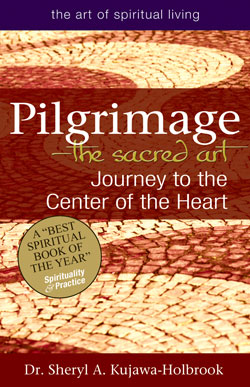A “Best Spiritual Book of the Year.”
—Spirituality & Practice
Integrates spirituality, practice, spiritual formation, psychology, world religions and historical resources. Examines how pilgrimages evolved as spiritual practices and the relationship between pilgrimage and transformation.
Dr. Sheryl A. Kujawa-Holbrook
Paperback
5½ x 8½, 240 pp | 978-1-59473-472-4
Explore the many dimensions of the pilgrimage experience and change your orientation to the world.
“Pilgrimage is an opportunity for pilgrims to cultivate their inner life (or inner voice) in a way that leads to a greater sense of peace and compassion—a sense that pervades all of life.”
—From Chapter 6, Preparing to Practice
Pilgrimage is a spiritual practice of nearly every major religion of the world. If you are a Christian you may travel to sites associated with the life of Jesus; Jews might visit the Western Wall in the Old City of Jerusalem and other sacred places in the Holy Land of Israel; Muslims participate in the Hajj, the journey to Mecca; Buddhists visit the sacred sites related to the life of Buddha. Even if you practice no religion at all you will still find that you most likely participate in this practice—the Jefferson Memorial in Washington, DC, and Lenin's tomb in Moscow are considered national pilgrimage sites. As a spiritual practice, pilgrimage transcends religious, national, cultural and linguistic boundaries.
This fascinating look at the sacred art of pilgrimage integrates spirituality, practice, spiritual formation, psychology, world religions and historical resources. It examines how the world's religious pilgrimages evolved as central spiritual practices and the relationship between pilgrimage and transformation. It explains what makes a place holy, and why and how some sites are so compelling that they attract thousands, even millions of pilgrims each year.
“A deeply satisfying—and oftentimes rollicking—account of one of the most important religious practices on earth.... You’ll love this book!”
—Mark Massa, SJ, dean, School of Theology and Ministry, Boston College
“Beautifully written ... will take the reader to the center of the heart as it did to me.”
—Deepak Shimkhada, PhD, president, Indic Foundation; professor of Hindu studies, Claremont Lincoln University
“Helping us claim our deepest heart’s desires and find our way ... a trove of insight, both ancient and new.”
—The Rev. Curtis Almquist, SSJE, The Society of Saint John the Evangelist, Cambridge, Massachusetts
“A timely and compelling invitation to both the secular and religious seeker.... Interreligiously aware, grounded in deep expertise and accessible.”
—Elena Procario-Foley, Driscoll Professor of Jewish-Catholic Studies, Iona College
“Stunningly insightful.... Should be sewn inside backpacks the spiritual world over.”
—Foreword
“A reflective journey through the liminal spaces of life where the need for meaning encounters the challenges and violence of contemporary experience.... Provides illustrative examples to structure the ways and means of spiritual homecoming.”
—Rodney L. Petersen, PhD, executive director, Boston Theological Institute
“Beautiful and sensitive.... Blend[s] the lines between theory and practice such that the religious scholar and the thoughtful practitioner might each learn from the other.”
—The Rev. Dr. Stephen Butler Murray, dean and associate professor of theology, Barrytown College; American Baptist chaplain, Harvard University
“A treasure trove of guidance and inspiration for that which Sufis say can never be found by seeking, yet only seekers find.”
—Imam Jamal Rahman, author, Spiritual Gems of Islam: Insights & Practices from the Qur’an, Hadith, Rumi & Muslim Teaching Stories to Enlighten the Heart & Mind
“A true feast for both mind and spirit.... To students, scholars, activists, artists, spiritual seekers young and old, I can only say: Take, read, savor, and embark!”
—Alexander Levering Kern, executive director, Center for Spirituality, Dialogue and Service, Northeastern University; poet and editor, Becoming Fire: Spiritual Writing from Rising Generations
Chapter 1
Journeys Across Traditions and Cultures 1
Pilgrimage Across Cultures and Religions 7
The Hindu Tradition 9
The Buddhist Tradition 11
The Greek and Roman Traditions 12
The Abrahamic Traditions 14
Secular Pilgrimage 33
Virtual Pilgrimage 37
Chapter 2
The Way of the Heart 40
Pilgrim Narratives 45
Jung and Images of Pilgrimage 53
The Stages of Pilgrimage 58
Spirituality of the Heart 64
Chapter 3
Holy Places, Sacred Spaces 75
Sacred Landscapes 78
Memory Places 84
Quiet Places 90
Divine Activity Places 95
Commercialization and Environmental Impact 99
Chapter 4
Walking the Labyrinth 106
A Single Path 111
Origins of the Labyrinth 115
The Labyrinth of Chartres Cathedral 119
Walking as Spiritual Practice 125
Chapter 5
The Journey Home 135
The Need to Belong 142
Home and Pilgrimage 149
Stories of the Journey Home 156
Chapter 6
Preparing to Practice 168
Beginning Spiritual Practice 169
The Practice of Prayer and Meditation 175
Spiritual Practices in Preparing for Pilgrimage 184
Practical Advice for Planning a Pilgrimage 185
Guidelines for Visiting Holy Places
and Sacred Spaces 188
The Benefits of Group Pilgrimages 193
Keeping a Record of Your Pilgrimage 196
Walking the Labyrinth 198
Returning Home 201
Acknowledgments 204
Notes 205
Suggestions for Further Reading 217
The destination of the pilgrim is not a place of relaxation or entertainment; it is not for cultural exploration per se. A pilgrim’s goal is transformation that requires rigorous and intentional psychological and spiritual work, often in the context of arduous travel experiences.
But for some pilgrims, it is the desire for the outward journey to a faraway place, the hope and excitement of the trek, which is most pronounced at the onset; there can be little sense of the inward journey that will soon emerge. For others, the journey to the center of the heart is primarily an inward one, a liminal experience and contemplative practice conducted in familiar environments and occupations, yet undertaken with an underlying sense of separation, transition, and incorporation.
Your book mentions that pilgrimage as a spiritual practice is found in many, if not most, spiritual traditions. What about those who are questioning their tradition?
A time of intense spiritual questioning is what often draws people to pilgrimage. When I was a young adult I had the opportunity to journey to the Taizé community several times on pilgrimage. I was very much drawn to the beauty of the physical setting, the contemplative worship, and the thousands of other young people who made the trip with me. I have been a Christian all my life, and yet at different times I felt the need to make the commitment anew, to go deeper, to reenvision my spirituality.
We live in a world where there is a deep hunger for the journey to the center of the heart. For most of our lives, we are pressured to turn our focus outward to meet the demands of the world, and that is what most of us do, at least until persistent dissatisfaction or some traumatic event challenges us to take stock of our inward journey and find our authentic selves. It is often when the outside world fails us that we realize that the source of real resilience lives within. It is through the resources of the inward journey that we survive change, cataclysmic events, and even death itself.
Your book suggests that pilgrimage as a spiritual practice contributes to healing the world. How so?
The world�s suffering will not disappear any time soon. However, it is through the inward-focused mystical traditions found in both Eastern and Western religions that we are encouraged to develop our hearts, and in doing so, we enrich our outward practice of compassion as well.
From the perspective of spiritual growth, the outward journey of action in the world and the inward journey of the heart are not binary opposites; they are meant to work together and to bring balance to the self. The point here is that human wholeness is achieved only when we take seriously the inward journey and bring it into better balance with our responsibility to engage the world.
If we are willing to stand fully in our own shoes and not give up on ourselves, then we will be able to put ourselves fully in the shoes of others and not give up on them. True compassion does not come from wanting to help those less fortunate than ourselves but from realizing our kinship with all beings. For instance, local, national, and international peace pilgrimages have a similar impact on participants. After leaving their social environments, such pilgrims meet and bond with others—with pilgrims from different religions, cultures, and ethnicities. Although peace pilgrims return to the same homes and businesses they left, it is not uncommon to hear the refrain, “I will never see the world the same way again.”
Chapter 1: Pilgrimage—The Sacred Art
- Reflect on your own experience of pilgrimage. When have you experienced being a pilgrim? What motivated you to go on the journey? What did you discover? If you are getting ready to go on pilgrimage now, what are you seeking?
- What images or words come to mind when you hear the word pilgrimage? What pilgrimage traditions most resonate with or challenge your own heritage or experience?
- Reflect on the phrase pilgrimage of life. Some pilgrimages do not require physical travel. Have you ever taken such a journey? How does the phrase relate to your own experience?
Chapter 2: Journey to the Center of the Heart
- Search the Internet for as many images of the heart as you can find until you find one (or more) which truly resonate with your own heart. In your own words, how would you describe your own journey to the center of the heart? Refer to your chosen image if it helps you articulate how you envision your own heart.
- Listen to your heartbeat. Where does the experience lead you in the present moment?
- What is your heart’s desire? Your deepest yearning? Your most profound aspiration? As the poet Mary Oliver asks, “What are you doing with your one wild and precious life?”
Chapter 3: Holy Places, Sacred Spaces
- Set aside a table, mantelpiece, or windowsill in your home, office, or some other significant place and begin to assemble a personal “altar.” Bring together your “sacred objects” to display in this holy place. For some people, these sacred objects may be intentionally religious or spiritual in nature. For others, the sacred objects may be from the natural world—stones, water, earth. Still others might want to include photographs or other visual images. What makes these objects and this space holy or scared for you?
- Reflect on your own sacred geography. What are the holy places and sacred spaces in your own spiritual landscape? What do they look like? Why are they holy or sacred?
- How do you honor your body? If the body is a sacred space, what practices shape this understanding for you?
Chapter 4: Walking the Labyrinth
- Take a walk and try to identify the spiral “circuit” pattern found in a labyrinth in your surroundings. Where are the patterns visible in your natural world?
- Draw an image of your own spiritual journey, marking significant people, places, and events along the way, and projecting into the future. Where are spirals and other significant patterns in this experience? If reflecting within a group, share your images with one another. Sometimes others are more adept at discerning patterns in our experience than we are at noticing them.
- Locate and walk a labyrinth in your own community. How did you experience it? What is the relationship for you between walking a labyrinth and pilgrimage?
Chapter 5: The Journey Home
- Where is “home” for you? What or where is that place where you feel you truly belong?
- Sharon Daloz Parks writes about the need for all who contribute to the common good to have threshold people and hospitable places. Who are the threshold people in your own life? Where and what are the hospitable places?
- How do you practice home-making? How do you contribute to shaping the common good in the environments you inhabit (household, workplace, communities, planet)?
Chapter 6: Preparing to Practice
- What is your spiritual practice? What are the joys and challenges of the practice for you?
- Reflect on the list of spiritual practice in Chapter 6. Are there any practices there, or elsewhere in your experience, which you feel might contribute to your spiritual growth?
- As you reflect on the pilgrimage of life, where do you see yourself now? How might you live more joyfully in the present moment?











